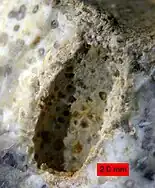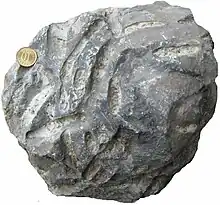Bioerosion
Bioerosion describes the breakdown of hard ocean substrates – and less often terrestrial substrates – by living organisms. Marine bioerosion can be caused by mollusks, polychaete worms, phoronids, sponges, crustaceans, echinoids, and fish; it can occur on coastlines, on coral reefs, and on ships; its mechanisms include biotic boring, drilling, rasping, and scraping. On dry land, bioerosion is typically performed by pioneer plants or plant-like organisms such as lichen, and mostly chemical (e.g. by acidic secretions on limestone) or mechanical (e.g. by roots growing into cracks) in nature.
This definition describes the chemical process of bioerosion, specifically as it applies to biorelated polymers and applications, rather than the geological concept, as covered in the article text. Surface degradation resulting from the action of cells.
Note 1: Erosion is a general characteristic of biodegradation by cells that adhere to a surface and the molar mass of the bulk does not change, basically.
Note 2: Chemical degradation can present the characteristics of cell-mediated erosion when the rate of chemical chain scission is greater than the rate of penetration of the cleaving chemical reagent, like diffusion of water in the case
of hydrolytically degradable polymer, for instance.Note 3: Erosion with constancy of the bulk molar mass is also observed in the case of in vitro abiotic enzymatic degradation.
Note 4: In some cases, bioerosion results from a combination of cell-mediated and chemical degradation, actually.[1]
Bioerosion of coral reefs generates the fine and white coral sand characteristic of tropical islands. The coral is converted to sand by internal bioeroders such as algae, fungi, bacteria (microborers) and sponges (Clionaidae), bivalves (including Lithophaga), sipunculans, polychaetes, acrothoracican barnacles and phoronids, generating extremely fine sediment with diameters of 10 to 100 micrometres. External bioeroders include sea urchins (such as Diadema) and chitons. These forces in concert produce a great deal of erosion. Sea urchin erosion of calcium carbonate has been reported in some reefs at annual rates exceeding 20 kg/m2.
Fish also erode coral while eating algae. Parrotfish cause a great deal of bioerosion using well developed jaw muscles, tooth armature, and a pharyngeal mill, to grind ingested material into sand-sized particles. Bioerosion of coral reef aragonite by parrotfish can range from 1017.7±186.3 kg/yr (0.41±0.07 m3/yr) for Chlorurus gibbus and 23.6±3.4 kg/yr (9.7 10−3±1.3 10−3 m2/yr) for Chlorurus sordidus (Bellwood, 1995).
Bioerosion is also well known in the fossil record on shells and hardgrounds (Bromley, 1970), with traces of this activity stretching back well into the Precambrian (Taylor & Wilson, 2003). Macrobioerosion, which produces borings visible to the naked eye, shows two distinct evolutionary radiations. One was in the Middle Ordovician (the Ordovician Bioerosion Revolution; see Wilson & Palmer, 2006) and the other in the Jurassic (see Taylor & Wilson, 2003; Bromley, 2004; Wilson, 2007). Microbioerosion also has a long fossil record and its own radiations (see Glaub & Vogel, 2004; Glaub et al., 2007).
Gallery
 Trypanites borings in an Upper Ordovician hardground, southeastern Indiana; see Wilson and Palmer (2001).
Trypanites borings in an Upper Ordovician hardground, southeastern Indiana; see Wilson and Palmer (2001). Petroxestes borings in an Upper Ordovician hardground, southern Ohio; see Wilson and Palmer (2006).
Petroxestes borings in an Upper Ordovician hardground, southern Ohio; see Wilson and Palmer (2006). Gastrochaenolites borings in a Middle Jurassic hardground, southern Utah; see Wilson and Palmer (1994).
Gastrochaenolites borings in a Middle Jurassic hardground, southern Utah; see Wilson and Palmer (1994). Numerous borings in a Cretaceous cobble, Faringdon, England; see Wilson (1986).
Numerous borings in a Cretaceous cobble, Faringdon, England; see Wilson (1986). Cross-section of a Jurassic rockground; borings include Gastrochaenolites (some with boring bivalves in place) and Trypanites; Mendip Hills, England; scale bar = 1 cm.
Cross-section of a Jurassic rockground; borings include Gastrochaenolites (some with boring bivalves in place) and Trypanites; Mendip Hills, England; scale bar = 1 cm. Teredolites borings in a modern wharf piling; the work of bivalves known as "shipworms".
Teredolites borings in a modern wharf piling; the work of bivalves known as "shipworms".
 Gastrochaenolites boring in a recrystallized scleractinian coral, Matmor Formation (Middle Jurassic) of southern Israel.
Gastrochaenolites boring in a recrystallized scleractinian coral, Matmor Formation (Middle Jurassic) of southern Israel. Osprioneides borings in a Silurian stromatoporoid from Saaremaa, Estonia; see Vinn, Wilson and Mõtus (2014).
Osprioneides borings in a Silurian stromatoporoid from Saaremaa, Estonia; see Vinn, Wilson and Mõtus (2014). Gnathichnus pentax echinoid trace fossil on an oyster from the Cenomanian of Hamakhtesh Hagadol, southern Israel.
Gnathichnus pentax echinoid trace fossil on an oyster from the Cenomanian of Hamakhtesh Hagadol, southern Israel. Geopetal structure in bivalve boring in coral; bivalve shell visible; Matmor Formation (Middle Jurassic), southern Israel.
Geopetal structure in bivalve boring in coral; bivalve shell visible; Matmor Formation (Middle Jurassic), southern Israel. Borings in an Upper Ordovician bryozoan, Bellevue Formation, northern Kentucky; polished cross-section.
Borings in an Upper Ordovician bryozoan, Bellevue Formation, northern Kentucky; polished cross-section.
See also
- Biopitting
- Geomorphology – Scientific study of landforms
- Biogeomorphology – Study of interactions between organisms and the development of landforms
- Coastal erosion – Displacement of land along the coastline
- Marine biogenic calcification
References
- Vert, Michel; Doi, Yoshiharu; Hellwich, Karl-Heinz; Hess, Michael; Hodge, Philip; Kubisa, Przemyslaw; Rinaudo, Marguerite; Schué, François (2012). "Terminology for biorelated polymers and applications (IUPAC Recommendations 2012)" (PDF). Pure and Applied Chemistry. 84 (2): 377–410. doi:10.1351/PAC-REC-10-12-04. S2CID 98107080. Archived from the original (PDF) on 2015-03-19. Retrieved 2013-07-27.
- Bellwood, D. R. (1995). "Direct estimate of bioerosion by two parrotfish species, Chlorurus gibbus and C. sordidus, on the Great Barrier Reef, Australia". Marine Biology. 121 (3): 419–429. doi:10.1007/BF00349451. S2CID 85045930.
- Bromley, R. G (1970). "Borings as trace fossils and Entobia cretacea Portlock as an example". In Crimes, T.P.; Harper, J.C. (eds.). Trace Fossils. Geological Journal Special Issue 3. pp. 49–90.
- Bromley, R. G. (2004). "A stratigraphy of marine bioerosion". In D. McIlroy (ed.). The application of ichnology to palaeoenvironmental and stratigraphic analysis. Geological Society of London, Special Publications 228. London: Geological Society. pp. 455–481. ISBN 1-86239-154-8.
- Glaub, I.; Golubic, S.; Gektidis, M.; Radtke, G.; Vogel, K. (2007). "Microborings and microbial endoliths: geological implications". In Miller III, W (ed.). Trace fossils: concepts, problems, prospects. Amsterdam: Elsevier. pp. 368–381. ISBN 978-0-444-52949-7.
- Glaub, I.; Vogel, K. (2004). "The stratigraphic record of microborings". Fossils & Strata. 51: 126–135. ISSN 0300-9491.
- Palmer, T. J. (1982). "Cambrian to Cretaceous changes in hardground communities". Lethaia. 15 (4): 309–323. doi:10.1111/j.1502-3931.1982.tb01696.x.
- Taylor, P. D.; Wilson, M. A. (2003). "Palaeoecology and evolution of marine hard substrate communities" (PDF). Earth-Science Reviews. 62 (1–2): 1–103. Bibcode:2003ESRv...62....1T. doi:10.1016/S0012-8252(02)00131-9. Archived from the original (PDF) on 2009-03-25.
- Vinn, O.; Wilson, M. A.; Mõtus, M.-A. (2014). "The Earliest Giant Osprioneides Borings from the Sandbian (Late Ordovician) of Estonia". PLOS ONE. 9 (6: e99455): e99455. Bibcode:2014PLoSO...999455V. doi:10.1371/journal.pone.0099455. PMC 4047083. PMID 24901511.
- Wilson, M. A. (1986). "Coelobites and spatial refuges in a Lower Cretaceous cobble-dwelling hardground fauna". Palaeontology. 29: 691–703. ISSN 0031-0239.
- Wilson, M. A. (2007). "Macroborings and the evolution of bioerosion". In Miller III, W (ed.). Trace fossils: concepts, problems, prospects. Amsterdam: Elsevier. pp. 356–367. ISBN 978-0-444-52949-7.
- Wilson, M. A.; Palmer, T. J. (1994). "A carbonate hardground in the Carmel Formation (Middle Jurassic, SW Utah, USA) and its associated encrusters, borers and nestlers". Ichnos. 3 (2): 79–87. doi:10.1080/10420949409386375.
- Wilson, M. A.; Palmer, T. J. (2001). "Domiciles, not predatory borings: a simpler explanation of the holes in Ordovician shells analyzed by Kaplan and Baumiller, 2000". PALAIOS. 16 (5): 524–525. Bibcode:2001Palai..16..524W. doi:10.1669/0883-1351(2001)016<0524:DNPBAS>2.0.CO;2. S2CID 130036115.
- Wilson, M. A.; Palmer, T. J. (2006). "Patterns and processes in the Ordovician Bioerosion Revolution" (PDF). Ichnos. 13 (3): 109–112. doi:10.1080/10420940600850505. S2CID 128831144. Archived from the original (PDF) on 2008-12-16.
Further reading
- Vinn, O.; Wilson, M.A. (2010). "Occurrence of giant borings of Osprioneides kampto in the lower Silurian (Sheinwoodian) stromatoporoids of Saaremaa, Estonia". Ichnos. 17 (3): 166–171. doi:10.1080/10420940.2010.502478. S2CID 128990588. Retrieved 2014-06-10.
- Vinn, O.; Wilson, M.A. (2010). "Early large borings from a hardground of Floian-Dapingian age (Early and Middle Ordovician) in northeastern Estonia (Baltica)". Carnets de Géologie. 2010: CG2010_L04. doi:10.4267/2042/35594.
- Vinn, O.; Wilson, M.A.; Toom, U. (2015). "Bioerosion of Inorganic Hard Substrates in the Ordovician of Estonia (Baltica)". PLOS ONE. 10 (7): e0134279. Bibcode:2015PLoSO..1034279V. doi:10.1371/journal.pone.0134279. PMC 4517899. PMID 26218582.
